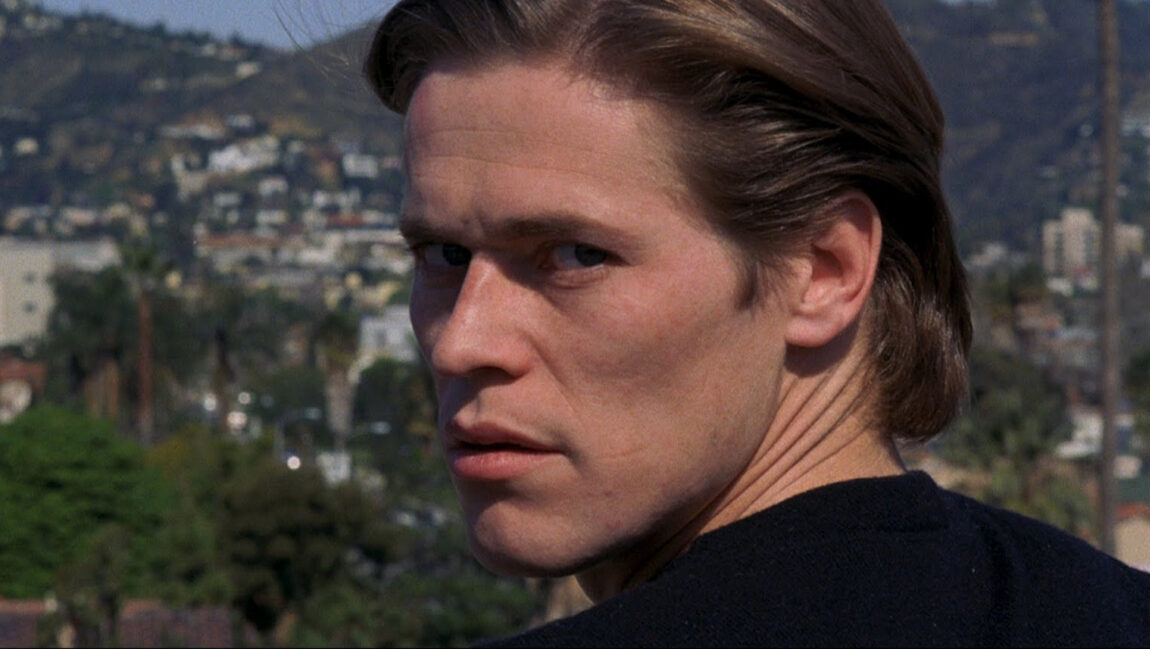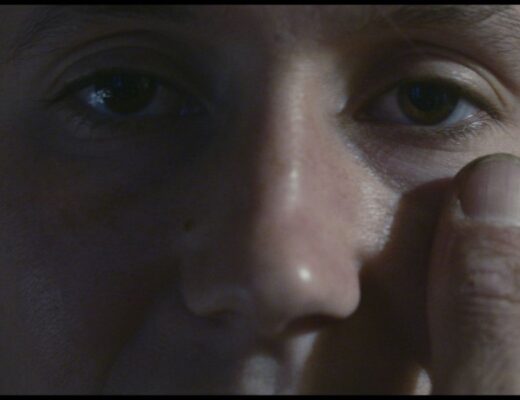OK, so things don’t really vanish anymore: even the most limited film release will (most likely, eventually) find its way onto some streaming service or into some DVD bargain bin assuming that those still exist by the time this sentence finishes. In other words, while the title of In Review Online’s monthly feature devoted to current domestic and international arthouse releases in theaters will hopefully bring attention to a deeply underrated (even by us) Kiyoshi Kurosawa film, it isn’t a perfect title. Nevertheless, it’s always a good idea to catch-up with films before some… other things happen.
Dear Santa
Documentary filmmaker Dana Nachman strikes again. Her latest effort, Dear Santa, is a film that, much like past efforts Batkid Begins and Pick of the Litter, seems to exist solely to indict film critics (this one, included) for their churlish and heartless ways. She’s a director who seemingly selects projects based solely on their “awww” factor and capacity to encourage tears from soft-hearted viewers who are drawn to such material like moths to flame. Cancer-ridden kids? Check. Guide dogs for the blind? Check. Nachman is obviously working her way through some checklist of would-be heart-melters. With Dear Santa, she sets her sights on Operation Santa, a program started over 100 years ago by the United States Postal Service with the purpose of answering letters addressed to one St. Nicholas from kids across the country. Over the years, the enterprise has evolved to also serve as a charitable organization, allowing individuals to “adopt” kids and families for the holiday season, sending presents to those who would otherwise go without. Nachman focuses her attention not just on the last two cities where participants can still go and read hard copies of the actual letters — New York and Chicago — but she also travels across the country to see how Operation Santa has inspired other areas to spread cheer and goodwill through the act of gift-giving.
I’m not going to be that critic to sit here and say I am not affected when someone reads a letter detailing that the only thing a child wants for Christmas that year is food. And I’m not made of stone when a gay 12-year-old asks for an expression of love and acceptance, even if only from Santa. The problem is that Nachman goes about her innately moving material with tactical manipulation, utilizing such affectations as treacly music and constant zoom-ins on tears to maximize the film’s near-oppressing emotionalism; the whole gambit leads to Dear Santa’s final montage where everyone receives their gifts and rejoices in unison. When you feel the film’s strings being pulled, it only further illuminates its disingenuousness. It doesn’t help that, whereas past projects were limited in their focus, Dear Santa tracks far too many people over the course of its brief 83-minute runtime. Before long, the multiple miseries begin to pile up, ultimately numbing the viewer to the potentially heartbreaking stories that are unfolding, and undermining the audience’s ability to become truly invested in any particular individual or storyline. It goes without saying that Dear Santa has its heart in the right place — that much can be fairly intuited from its title — and its manipulations do not preclude tears from welling, but it’s fair to wish it had earned its weepiness a little more graciously. On that note, I’ll just sit back and anxiously await Nachman’s next project, which will undoubtedly involve a special program that trains kittens to save babies from house fires, and will once more make a grinch of me. Merry Christmas, Dana. Steven Warner

Credit: Outsider Pictures
Kill It and Leave This Town
Although their cinematic cachet may have diminished since their heyday, animated films have always been a prominent form of artistic expression in Eastern Europe. Often, these films reflect eccentric and even avant-gardist tendencies, finding their fans among arthouse and festival audiences more than the general public. Through considerable innovation and frequent unconventionality, these works tend to welcome viewers into more free, surreal, and complicated territories, but it’s also not uncommon, thanks to recent histories, for such works to bear forth some acerbic, socio-political satire. Kill It and Leave This Town fits fairly nearly within this loose tradition. For his debut feature, Polish screenwriter and director Mariusz Wilczyński utilizes a minimalist, hand-drawn style — doodles might be a more precise descriptor — often rendered on lined paper even, to weave his haunted childhood memories into a very raw, grotesque, and nightmarish fantasy. Approximately 15 years in the making, Wilczyńsk’s culminating vision is something like free association horror; here, animated frames of black-and-white sketchings — occasionally colorized to punctuating effect, drawing attention to certain details or emphasizing moments of dramatic lighting — create grim and gruesome images, even melancholic, that enhance both the film’s prevailing expressionistic mode and its disorienting mood. It makes for a distinctly enthralling quality, empowering Wilczyński’s phantasmagoric tale rife with senility, decay, death, and forbidden love in an industrial town that is both decadent and godforsaken.
But, regardless of the director’s creative energy and the hypnotic feast of images he crafts, there’s also an agitating undertone to his film. The fact that Kill It and Leave This Town was first conceived as a short film is the most obvious issue and predictive of the ways in which it wears itself thin during its 88 minutes. In other words, while the work here initially registers as intriguing, eye-catching novelty, it loses much of its inceptive force before long, becoming occasionally tedious and imagistically repetitive as the scenes stack. Another part of the problem is evident in how Wilczyński seems to tend toward the contemporary Eastern Bloc trend of miserabilism and blankets everyone and everything (including himself) in a blasé misanthropic nihilism. There’s little room within the film’s bleak mercilessness to perceive any profundity amid the suffocating dirtiness, ugliness, and suffering. In this way, it’s easy to find similarities between Kill It and Leave This Town and fellow Polish director Paweł Pawlikowski’s Cold War; it’s as if Wilczyński’s debut borrows from that film’s oppressing temperament while also subsuming something of the waggish spirit and comic quiddity of Bulgakov’s The Master and Margarita into its unique calculus. It’s those latter similarities that will aid viewers in discerning the inspired moments and artistic promise of Kill It and Leave This Town amidst the abrasive and sullen propensities with which Wilczyński seems subconsciously obsessed. It’s also what suggests the potential for a more cohesive and compassionate work in the future. Ayeen Forootan
Songbird
The press materials for the new COVID thriller Songbird spill a lot of ink on the filmmakers patting themselves on the back for creating a movie about “hope” and “resilience” in the middle of a global pandemic. It’s worth asking why they felt compelled to make anything at all, particularly such a bland, familiar, YA-inflected bit of star-crossed-lovers pablum like this. Setting aside whether it’s a good idea or not, or even moral (a big ask, frankly), Songbird only really makes sense as low-budget exploitation, like an old made-for-TV movie ripped from the headlines or a vintage Arkoff or Corman drive-in quickie that wanted to advertise its novelty factor. The best thing that can be said about Songbird is that it at least looks and feels like an actual movie, albeit a bad one, despite the unique provenance of its creation (although not that unique, not anymore, as many movies and television projects have since resumed production).
In this alternate reality, COVID-19 has mutated into COVID-23, causing something like one hundred million deaths worldwide. Most people live in perpetual lockdown, while a handful of immune folks traverse once-vibrant cities with special wristbands indicating their immunity status. One such “munnie,” as they are referred to in the movie, is beefy boy-toy Nico (KJ Apa), who works as a bike messenger for Lester (Craig Robinson), squiring packages all over an empty, desiccated L.A. Even in the midst of an apocalyptic pandemic, the rich can still get whatever they want, apparently. Nico is saving his money up for fake credentials to get his girlfriend Sara (Sofia Carson) away from the city to a “free zone.” Meanwhile, the Department of Sanitation, led by that strangest of “hey-that-guy” character actors Peter Stormare, has been weaponized; anyone who tests positive during daily temp checks is dragged away by armed stormtroopers and left to die in “Q zones,” which look suspiciously like concentration camps. It’s an example of the kind of logistical questions that the film can’t be bothered to answer, and it’s impossible to glean any kind of coherent political position from its confused scenario. It’s certainly alarmist, but only in the dumbest sense, extrapolating current events into Walking Dead territory (minus the zombies). Meanwhile, Nico’s travels have him cross paths with a rich couple (Demi Moore and Bradley Whitford, presumably picking up easy paychecks), and there’s also a weird subplot shoehorned in about a musician/cam girl (Alexandra Daddario) and a wheelchair-bound drone pilot (the always welcome Paul Walter Hauser). It doesn’t make a ton of sense, and screenwriter Simon Boyes contorts himself trying to tie all these loose threads together.
At least director Adam Mason and cinematographer Jacques Jouffret invest the proceedings with a ton of energy, channeling the hyper-kinetic style of producer Michael Bay’s best work. Almost every scene here is mediated by screens, as people communicate via phones, tablets, drones, and security cameras. It’s a phalanx of digital images, a tapestry of technology with a frenzied editing style to match, and very much of a piece with other movies that InRO editor-in-chief Luke Gorham has dubbed “telecom cinema” (think Unfriended and its ilk). There’s a fascinating ephemeral quality to the digitized images, a sketchy, fuzzy surface effect that becomes a kind of pliable metaphor for distanced interpersonal relationships. This aesthetic leaning helps the early goings of Songbird to remain quite a bit of fun, but the plot inevitably kicks in, and the film grinds towards its forgone conclusion. The overwhelming feeling one is left with is that all this creative energy could have been put to better use elsewhere, and that Mason & Co. were so clearly preoccupied with whether or not they could do it that they didn’t stop to think about whether they should do it. Daniel Gorman

Credit: Lionsgate
Smiley Face Killers
Brett Easton Ellis has never written a sympathetic character in his entire career. There are two types of people to be found in an Ellis opus: young, pretty, and vacuous or young, pretty, and harboring personal demons while maintaining an aura of vacuousness. He’s a peculiar choice, then, to pen the new horror flick Smiley Face Killers, a film that focuses not on the titular killers, but instead on one of their potential victims, the young, pretty, and vacuous Jake Graham (Ronen Rubinstein). Ellis has no interest in developing this character beyond the most superficial flourishes: he’s a twenty-something college student who is cut like a Greek God and spends most of the film in various states of undress. He has a willing partner in director Tim Hunter — a long way from his breakout film, 1986’s cult classic River’s Edge — who is far more interested in ogling Rubinstein’s physique than in frightening audience members. Just watch as Jake emerges from the pool, his small black trunks clinging to his lithe, muscular body, the camera slowly panning over every inch. One could be mistaken for thinking this was the latest David DeCoteau flick, a healthy dose of palpable homoeroticism informing every scene. That’s not to say that Jake is lacking a rich interior life: he suffers from unnamed mental issues, has recently stopped taking his meds, and is jealous of his girlfriend’s ex. He also likes to put on shirts even while his body is still slick and glistening from a recent, steamy shower — the kid has layers.
Sixty minutes of Smiley Face Killers is devoted to the “development” of this character, who at one point repeats the line, “Why are you fucking with me, bro?” three times in the span of ten seconds. Every once in a while, a white van pops up in the background, silently stalking our protagonist, before one of the perpetrators finally moves to the interior of his apartment to get a better look at that ass. The history surrounding this case is actually a fascinating one — yes, this is inspired by actual events, and involves an absolutely insane theory on how the “accidental” drowning of over 150 athletic, college-aged males over the course of 20 years may be linked to a serial killer whose calling card was a spray-painted smiley face. Ellis takes a few liberties here and there, namely by theorizing that the possible culprits were a bunch of Satanists, which is certainly one avenue to pursue. What makes Smiley Face Killers such a fascinating failure, though, is just how much the film gets right. DP Michael Marius Pessah favors soft, ambient light in his nighttime scenes, all street lamps and headlights, that reminds of Michael Mann’s Collateral more than it has any right to; it’s highly effective in creating a very specific mood of discomfort and encroaching fear. The synth score by Kristen Gundred is also a neat little nod to the ‘80s-esque, devil-worshipping cultists at the heart of the film, and Crispin Glover even pops up as one of the trio of killers, sporting a bald head and a bit of discount Lon Chaney make-up. He doesn’t have much to do and is clearly only around as a personal favor to director Hunter, but his gonzo presence is always an attention-getter, to say the least. Meanwhile, for gorehounds unimpressed by the film’s more nuanced efforts, the killings are especially graphic, although it unfortunately takes an hour before Hunter and company get to the “good stuff.” It’s a legitimate bummer, then, that viewers must suffer through so much bad stuff in the meantime. The dialogue and acting are brutal in all the wrong ways, although Rubenstein gets credit for having the balls to spend the last third of the movie entirely naked, save for a wrapping of electrical tape covering his bits. Why, you ask? Well… [Turns to look at Ellis, who lights a Marlboro Red and cackles, refusing to break eye contact.] Smiley Face Killers isn’t good per se, and there’s a whole lot of mess to wade through, but it’s never less than a compelling watch, if not always for the reasons intended. Steven Warner
Survival Skills
“That uniform doesn’t give you the right to kill whoever you want.” It’s hard to think of a more incendiary line being uttered in any 2020 film than this one from Survival Skills, the feature-length debut from writer-director Quinn Armstrong. What starts as a pitch-black comedy slowly morphs into devastating social commentary, made sharper simply by the moment in history at which it arrives. Armstrong is certainly fully committed to his vision, the tale of a 30-year-old man from Any Town — well, make that Middletown — USA and his first year as an officer on the local police force in the late 1980s. Armstrong presents his film as a police training video, filmed almost entirely on era-appropriate VHS tape, with the expected static and tracking issues that would accompany such a format. (Bonus points to the sound design here, which utilizes the fuzz of said static to create a pulsating atmosphere of menace and dread.)
Jim Williams (Vayu O’Donnell) is a white, Christian man, and he lives his life according to “the rules.” Almost instantly, he is forced to reconsider everything he believes after encountering a mother and daughter involved in a domestic violence case. The more he tries to help, the worse things get — both officers and citizens are affected by a broken system that fails to protect and serve. Jim possesses a certain heartbreaking idealism, the belief that one good man can make a difference, but this is contrasted sharply by Jim’s partner, Allison (Ericka Kreutz), a grizzled veteran who has become disillusioned by the very people she is supposed to defend. After one particularly brutal diatribe, Jim intones to her, “I don’t think you should be a police officer.” Moments like this welcomingly complicate and make more palatable the film’s otherwise questionable message, as does Armstrong’s decision to keep his attention on Jim’s specific course rather than any comprehensive assessment.
An argument could be made that blaming a corrupt system for the actions of one individual is both reductive and ignorant — and rightfully so — but Armstrong has an ace up his sleeve in the film’s final ten minutes, removing a lot of the inherent, palate-deadening bitterness in the process. It’s too bad, then, that he couldn’t get a better handle on the film’s tone, which veers wildly from broad comedy to kitchen sink drama to something akin to a Lynchian affect. That inconsistency extends to the film’s character work: nabbing Stacy Keach to narrate was a particular boon to the production, as his menacing growl adds a level of consistency to the proceedings that most certainly was not present on the page, but it’s tough to tell what the hell is going on with Jim’s wife, a Stepford-esque cipher who seems to be visiting from another planet — and another film — altogether. Even worse, Armstrong’s choice to essentially ignore anything related to race seems like, pardon the pun, a cop-out. Despite these obvious problems, Survival Skills remains a bolder film than it at first appears, and could at the very least provoke a few enlightening conversations at a time when they are deeply needed. That’s worth something, even if it’s not a lot. Steven Warner

Credit: Gravitas Ventures
Don’t Click
In 1997, Michael Haneke unleashed Funny Games onto an unsuspecting public. A chillingly effective home invasion thriller, the film also served as a hectoring bromide against all those that might enjoy… a chillingly effective home invasion thriller. Regardless of what one might think of the Austrian’s tautological gambit (this critic is firmly in the ‘it stinks’ camp), Haneke’s command of his craft is undeniable. Now, almost 25 years later, comes Don’t Click, an amateurish horror cheapie that attempts to meld the confrontational tone of Funny Games with an aesthetic cobbled together from Cronenberg’s Videodrome, the Saw franchise, and even bits of Hellraiser’s iconic cenobites. Lest that description sound intriguing, be advised that Don’t Click is a boring, unpleasant, and intellectually bankrupt exercise in literal torture porn that only masquerades as an indictment of its (hopefully purely hypothetical) audience.
It’s a simple, if bizarre, set up: introverted college dude Zane (Mark Koufos) frequents a snuff-torture website called “Beat a Bitch Dot Com,” until he is mysteriously teleported through his laptop to a doorless and windowless room. His roommate Josh (Valter Skarsgård) stumbles across the open computer and he too is zapped to the same room. There, a deranged, mute man with a rictus grin and face wounds forces Josh to torture Zane, with each encounter involving the removal of some piece of Zane’s anatomy. These scenes are interspersed with flashbacks of Josh and Zane moving in together and having tedious, awkwardly staged conversations, as well as more scenes of the offensive website and various women being beaten and murdered. It would be more upsetting if it wasn’t all just so tedious and banal. Don’t Click flits between its two sets (by the way the film literally features only two sets, the boy’s apartment and the torture chamber) before eventually introducing a vengeful ghost who explains what’s going on: Zane is being punished for visiting the website, while Josh is culpable for ignoring the warning signs. There’s a germ of an idea here — that men let other men off the hook for bad or even outright disturbing behavior. But this crummy movie is hardly an appropriate vehicle for such commentary. Director G-hey Kim and co-writer Courtney Ellum have crafted a cautionary tale about the internet that would have been dated even a couple decades ago, with a heavy dollop of think-about-the-children moral panic. Worst of all, Kim is an utterly inept filmmaker: the camera always seems to be in the wrong place and there are long sequences shot at different frame rates that are headache-inducing. Don’t Click isn’t even a so-bad-it’s-good situation; this has zero chance of becoming any kind of cult success. It’s always hard to resist low-hanging fruit, so let’s not: the filmmakers teed up the right response to their misbegotten pile of shit. Don’t watch. Daniel Gorman
Love, Weddings & Other Disasters
Dennis Dugan has gifted the world some of Adam Sandler’s best films (Happy Gilmore and You Don’t Mess With the Zohan stand out) and punished it with some of his worst (Jack and Jill, Grown Ups). Who could have guessed, though, that the man secretly harbored a desire to become the next Garry Marshall? That director’s formula for romantic comedies featuring star-studded ensembles and multiple intersecting storylines gets quite a workout in Love, Weddings & Other Disasters. In fact, if Marshall hadn’t died in 2016, one could be forgiven for mistaking this thing for yet another product from the same factory line as Valentine’s Day and New Year’s Eve. The non-descript, workmanlike direction resembles late-‘90s sitcoms (very Marshall), and there are lots of shamelessly mugging extras (that one can only imagine are close, personal friends of the filmmaker). The half-assed jokes and underdeveloped storylines also scream Mother’s Day (one of the worst films I’ve ever seen — and Love, Weddings & Other Disasters is no worse than that one, so credit where it’s due). The one stark difference? No huge A-list cast; only Diane Keaton and Jeremy Irons lend star power.
There are many things I did not expect when I sat down to watch Love, Weddings & Other Disasters, a hypothetical list that may have included: seeing Richard Kline, best known as Jack’s horn-dog best friend Larry from the Nick at Nite staple Three’s Company. Comparatively, having Kline’s character fix up their friend on a blind date with a literal blind woman is a bit more predictable. Keaton plays the blind woman, and she’s chosen to play her role as broad as possible; I’m talking looking-at-a-wall-when-talking-to-other-people broad. One hopes she was directed to act this way, because for the love of God, she was freakin’ Annie Hall! Here, the actress is made to trip over multiple pieces of furniture. At one point, the film’s other star, Irons, has to wear a blindfold to simulate being blind — and then falls down an escalator. I have no clue how Dugan convinced these two to be in this film, although it is quite possible they are the worst part. Faring much better is, of all people, Maggie Grace, who plays a wedding planner trying to overcome public embarrassment after a botched engagement. Grace has real chemistry with her tentative love interest (Diego Boneta); the two even share a few moments of welcome sweetness. The same certainly can’t be said for the subplot involving a reality show, a stripper chained to a gambling addict, and the mafia. There is also a storyline about a Boston tour guide looking for his lost “Cinderella,” a woman with a tattoo of a glass slipper on her neck. Jesus. And I haven’t gotten to music artists Elle King and Jesse McCartney, who pop up here and surprisingly do not play themselves; because even they, presumably, were too embarrassed to associate their brands with this thing. Anyway, hey, Sandler: please take Dugan’s calls. The man is struggling over here. Steven Warner







